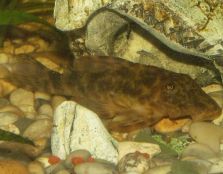Clown Pleco
(Panaqolus Maccus)
Alternate Names:
Clown Panaque
Ringlet Pleco
 Clown Pleco (Panaqolus Maccus) |
Size: 5 inches Temp Range: 73°F to 82°F pH Level: 6.8 to 7.6 Lifespan: 2 to 6 years Tank Size: 20 gallons Diet: Pellet, Flake, Vegetable Difficulty: Moderate |
Geographic History
These little catfish are from Venezuela. They are found in the Apure and Caroni River basins. Their natural habitat is in areas with driftwood near riverbanks.
Enviornment
You should provide a planted tank with lots of hiding spots. Clown Plecos especially love driftwood and will graze algae from it enthusiastically.
Compatibility
These peaceful little Plecos are a beautiful addition to your community aquarium. They may be semi-aggressive with other Plecos, especially the males. If given enough space, there will be few problems with their own kind.
Sexing
Males develop enamel growths on their backs during adulthood. They may be hard to sex until they are quite mature. Males may also have more barbels than females, but this is not always the case.
Behavior
The Clown Pleco is a shy and peaceful fish. It will defend a small patch of of your aquarium's real estate against other Plecos though. They will usually stay within six inches of their chosen territory, most likely a small piece of driftwood or a favorite hiding spot.
These nocturnal fish will spend most of the day hiding under driftwood or behind a heavily planted area. At night they come out and scavenge for bits of food and algae. They will be most often seen, especially as juveniles, as a shadow hanging off the glass or a strange hump on a piece of aquarium decor.
Sometimes you will see these fish shoot up to the surface and then rush back into hiding. They gulp air to aid in their bouyancy. Be sure that you have a tight hood because they will sometimes misjudge the distance and jump out of the water.
Breeding
Inducing spawning can be a complex and somewhat difficult task. It is best attempted in a special breeding tank because the changes in water conditions will probably kill other fish in a community aquarium.
After providing some tubes or pipes large enough for the male to completely disappear in, add the spawning pair to your breeding tank. In a day or two, do a 70% water change. This is where things get a little tricky. You are going to try and simulate the rainy season in their natural habitat.
The replacement water you add to your breeding tank will need to be of neutral Ph value. Most people accomplish this with rainwater. The replacement water will need to be just a few degrees cooler than the orginal water when you add it. After adding the replacement water, put an aquarium heater in the breeding tank and slowly warm the water to the upper limit of the Clown Pleco's temperature range. While you wait for the temperature to climb, it may take a couple days, change the type of food you are feeding your spawning pair to something different.
The male will entice the female to swim inside its breeding tube and lay eggs. Go ahead and remove the female from the breeding tank after she lays her eggs because she will have no other part in the spawning process. The male will then stay in the tube until the eggs hatch and the fry are swimming. This takes about ten days.
You can feed the fry crushed algae chips and crushed flake food. There will be somewhere around 200 fry after the eggs hatch. Having a bare bottom in the breeding tank will aid the fry in finding food when they start swimming.
You will need to keep excellent water quality throughout this process, especially when the fry hatch. When you remove the female, you should start a daily schedule of 10% water changes to accomplish this.
For more information, go to Wikipedia's Clown Pleco page.





